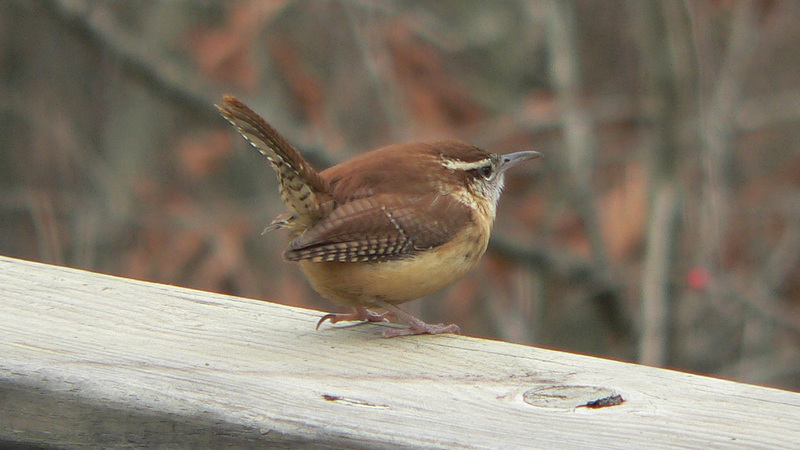Carolina Wren (Thryothorus ludovicianus) - wiki Carolina Wren
From Wikipedia, the free encyclopedia
[Photo] A Carolina Wren (Thryothorus ludovicianus) on a wooden rail. Photo taken with a Panasonic Lumix DMC-FZ20 in Johnston County, North Carolina, USA. Date 12:08PM 10JAN06. Author Ken Thomas www.kenthomas.us
The Carolina Wren (Thryothorus ludovicianus) is a common species of wren resident in the eastern half of the USA, the extreme south of Ontario and Quebec, Canada, and the extreme northeast of Mexico. A very distinct population in the Yucatan Peninsula of Mexico and Belize is treated either as a subspecies Thryothorus ludovicianus albinucha, or as a separate species, White-browed Wren Thryothorus albinucha. Following the review by Mann et al. (2006), these are the only forms remaining in the genus Thryothorus. This is the state bird for South Carolina.
It is a fairly large wren, of the US species, second largest after the Cactus Wren, typically 14 cm long and about 20 g weight. The upperparts are rufous brown, and the underparts a strong orange-buff, usually unmarked but faintly barred on the flanks in the southwest of the range. The head has a striking pure white supercilium (eyebrow) and a whitish throat. The race albinucha is duller brown above and has additional white streaking on the head.
It is easiest to confuse with the Bewick's Wren, a fairly close relative (Mart??nez G??mez et al. 2005), which differs in being smaller but with a longer tail, grayer-brown above and whiter below.
Ecology
Populations in Canada and the northern half of the US experience regular crashes following severe winters, but their high breeding productivity soon results in a return to higher numbers. These birds are generally permanent residents throughout their range and defend territory year round; some birds may wander north after the breeding season.
These birds prefer sites with dense undergrowth, either in mixed forests or in wooded suburban settings, in a natural or artificial cavity. The nest is a bulky, often domed structure, with a small hole towards the top. Nests of the more domestically-inclined wrens have been reported in a great variety of nooks and crannies in, about, or under buildings of various kinds, under bridges, or in holes in any structure such as a fence-post, tree, house or barn. Almost any kind of receptacle may offer an acceptable nesting site. Pairs may mate for life.
Females typically lay between four to six eggs (normally over a period of several days) up to three times per year (but normally only twice). Eggs are oval, grayish-white and sprinkled with reddish-brown spots. Incubation is performed by the female only and lasts anywhere from 12-14 days, with the first young leaving the nest 12-14 days after hatching. Both the male and female feed the young. If conditions are right, the same nest may be used more than once.
These birds eat insects, found in leaf litter or on tree trunks; they may also eat small lizards or tree frogs. In winter, they occasionally eat seeds, berries, and other small fruits.
Song & Calls
The Carolina Wren is noted for its loud song, popularly rendered as "teakettle-teakettle-teakettle". This song is rather atypical among wrens, which tend to sing songs which are similar to other wrens' songs. A given bird will typically sing several different songs. Only the male birds sing their loud song. The songs vary regionally, with birds in northern areas singing more slowly than those in southern areas.
The Carolina Wren also has a series of calls, including a rapid series of descending notes in a similar timbre to its song, functioning as an alarm call, and a very harsh and loud scolding call made to threaten intruders.
Interesting Carolina Wren Facts
The Carolina wren is sensitive to cold weather. Since they do not migrate and stay in one territory the northern populations of Carolina wrens decrease markedly after severe winters. However, since the winter temperatures over the last century have been increasing, the Carolina wrens have expanded their range northward since the mid-1900s.
http://en.wikipedia.org/wiki/Carolina_Wren
| The text in this page is based on the copyrighted Wikipedia article shown in above URL. It is used under the GNU Free Documentation License. You may redistribute it, verbatim or modified, providing that you comply with the terms of the GFDL. |
